Like animals at the local watering hole, humans, too, have different attributes they put on display amongst their co-workers. But which venery we vibe with mainly depends on the way we use our body language in the workplace.
Because first impressions are everything, right? And with many of us putting a magnanimous emphasis on our professional lives, it only seems logical to know how to verbalize nonverbally.
While mistakes are a part of life (so don’t sweat too much over it), it’s always in our best interest to try and improve. And our body language is the best place to start.
Why is body language important in the workplace?
Your body gestures speak volumes—55%, as a matter of fact (38% is tonality, and only 7% is verbal). And the way you carry yourself in public, especially in an office environment, can be the reason you make it or break it professionally.
For example, a head tilt during a presentation is positive body language in the workplace. It expresses that you’re interested. (A negative one, though, would be if you’re slumped in your chair during a one-on-one meeting. This indicates that you’re bored or uninterested.)
Sure, “work from home” allows us to slump a little—click-clacking on our laptops in bed, doing reports while scanning the latest Netflix release, or giving out a loud yawn during virtual meetings, allowing the “socially awkward” persona in us to be on Cloud Nine.
Face-to-face interactions, however, allow you to use your workplace body language to support or negate without having to utter a single word.
5 common mistakes when it comes to body language in the workplace
Many of us aren’t aware of how we speak with our bodies. And when we try to use gestures to show we’re empaths, pumped, uncomfortable, and whatever else, we sometimes throw out the wrong signals.
“Have you ever met someone for the first time and quickly realized they don’t warm to you?” asks Barbara Pease, co-trainer of Mindvalley’s Mastering Body Language: Truth, Lies, Love & Power Quest. “What signals are your body language sending?”
Looking at the smudge on our shoe can be interpreted as “come hither.” Or the blasting of cold air from the vents forces us to cross our arms, but it’s taken as negative body language in the workplace.
This is no bueno. So what workplace body language mistakes are commonly made? Here are five that Barbara and her husband, Allan, highlight in their Quest on Mindvalley.
Mistake 1: Not understanding the body language in different cultures
Before diving into the topic at hand, it’s important to note that different cultures have different ways of communicating. And with the magic of the internet, we all now have the opportunity to be connected to each other—work-wise as well.
One example Allan Pease, “Mr. Body Language” himself, gives in the Quest is how people answer “yes.” A head nod is sufficient in many places. However, in India, it’s a head wobble. And in Bulgaria, it’s a head shake.
So in the professional realm, you can get an up if you make a note of the way different cultures use body language, especially if you have clients or co-workers who are from various parts of the world. It shows effort, respect, and honor.
Mistake 2: Holding eye contact for far too long
Eye contact is key in body language; it’s even one of the signs of attraction. But can maintaining eye contact be a bad thing?
“It depends on the country you’re in,” according to Allan. For example, in South America and Japan, people will look away 80% of the time and look back 20% of the time. Allan adds, “Looking in the eyes in those places is seen as being offensive or aggressive.”
While you might not go to those regions of the world or interact with people from there on a daily basis, the question still remains: what’s the appropriate amount of time for eye contact?
Science has the answer. A 2016 study measured the pupil dilation of 500 volunteers to see how long they could make eye contact before it started to feel uncomfortable. The time: 3.3 seconds.
Mistake 3: Crossing arms
This gesture is often people’s go-to when there’s a dislike or disdain. However, it isn’t at all effective when you’re learning how to resolve workplace conflict with body language.
“Arm crossing is one of the biggest no-no’s,” says Allan. “You don’t want to use it, you don’t want to have it in your repertoire. In fact, get rid of it altogether.”
There are several types he highlights:
- Closed-fist arm crossing. Closed hand gestures along with crossed arms depict anger, annoyance, displeasure, and so on. You won’t be able to convince them of anything.
- Self-holding. It kind of looks like the person hugging themselves and is a common pose when a person is in a stressful situation.
- The broken-zipper position. The person holds their hands with themselves like they’re covering their groin area as if they have a broken zipper — hence the name.
So next time you’re in a situation where you feel insecure, defensive, or anxious, try with all your might not to cross your arms.
Mistake 4: Using the tight-lipped smile
This type of smile is where the lips are pursed and no teeth are visible, also known as the fake smile. (Interestingly enough, it’s used more often by women than men.)
“If humans can’t see your teeth, they are skeptical,” says Allan, adding that when they’re more likely to relax when they see those pearly whites.
However, there’s a limit to how wide your grin should be. A 2017 study found that wide smiles that show a lot of teeth aren’t exactly the best at creating a positive impression. While there’s no “bad” smile, their results did show that asymmetrical smiles were more attractive than perfectly sympathetic ones.
And on a side note, this is also a useful dating tip.
Mistake 5: Not orienting the body toward the person
If you’re familiar with season one of New Girl, you may remember that scene where Nick unconsciously points his feet toward Jess and she flips out. But that’s what we do as humans — we point our feet toward people we like and away from those we don’t.
Try this experiment next time you’re observing body language in the workplace: stand with a group of people during a meeting or social hour, and look down at their feet. You may notice that most will tend to point their feet toward the most interesting person in the room.
Similarly, if the person’s head is facing you but their feet is pointing in a different direction, they’re telling you that they want to be elsewhere, according to Allan. He adds that if you’re talking to a co-worker or client and their feet’s pointing in another direction, you may want to change your topic or find something to draw their attention back in.
Additionally, to show interest and make someone feel important, we tend to lean towards people we like and lean away from those we don’t. It’s essential, though, not to lean in too much that it invades the person’s personal space.

How to accurately read workplace body language
It may not be obvious to some, but effective communication extends to body language as well. Like its verbal counterpart, nonverbal communication has its structure and format that helps to create meaning and messages.
People who are often described as ‘perceptive’ are those who can read the body language’s words, sentences, and punctuation and can accurately match them against what’s being said.
— Barbara Pease, co-trainer of Mindvalley’s Mastering Body Language: Truth, Lies, Love & Power Quest
There are three rules, according to Barbara and Allan, that you should follow when reading body language in the workplace:
1. Read gestures in clusters of three
A “cluster” is another word for “sentence.” And when you’re interpreting your co-worker’s body language, make sure you’re doing it in clusters of three.
There’s a good reason for this: it’s to avoid assumptions and misunderstandings.
Many people tend to read only one gesture and give meaning to it. This is like reading one word and trying to decode the whole sentence.
The thing is, one gesture can mean several things. For example, if someone rubs their nose, it could mean they’re lying. Or it may just simply be that their nose is itchy.
So remember: clusters of three.
2. Read gestures in context
What’s one of the best ways to avoid a misunderstanding? Understanding the context. And this interpersonal skill goes for verbal communication as well as body language.
Let’s take the “yes or no” head gestures as an example. Here’s a look at the context and interpretation.
| Example 1 | Context: Your co-worker nods their head. | Interpretation: In most parts of the world, this means “yes.” However, in Bulgaria, it means “no.” |
| Example 2 | Context: Your co-worker shakes their head. | Interpretation: This means “no” in most cultures around the world. But to Bulgarians, it means “yes.” |
Context is key, as the saying goes, lest you want HR to call you up because you thought someone was doing the “eye flash” at you when they were just adjusting their contact lenses.
3. Look for congruence
Your co-workers can “talk the talk,” but can they “walk the walk”? That’s basically asking if their actions match their words — and that’s what congruence is all about.
It’s an important aspect of body language, according to Allan. Because if there’s no congruence, there’s a higher chance for mistrust.
So when you’re reading body language in the workplace, make sure you’re reading it in threes, understand the context, and see if the words match the person’s actions.
Let your body do the talking
We often stumble on our words, and it’s the same when we speak with our bodies. However, like learning any language, there are ways you can master your unique vernacular.
Mindvalley has several quests that can help you level up professionally. When it comes to body language in the workplace, you can start with Mastering Body Language: Truth, Lies, Love & Power Quest with Allan and Barbara Pease.
Signing up for a free Mindvalley account comes with some awesome advantages. You can view selected quest classes, access a vast library of meditations, and be part of a global community of like-minded people.
So seek your greatness at Mindvalley. Welcome in.









